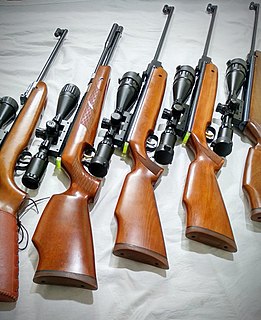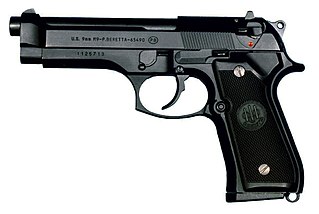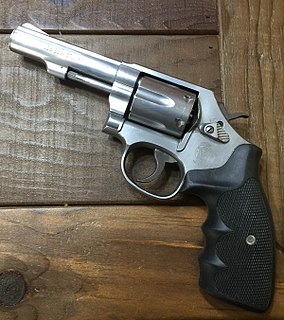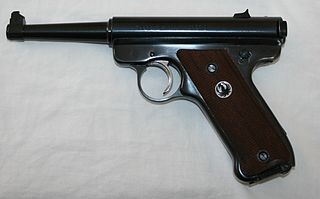
Single-shot firearms are firearms that hold only a single round of ammunition, and must be reloaded after each shot. The history of firearms began with single-shot designs, and many centuries passed before multi-shot repeater designs became commonplace. Single-shot designs are less complex than revolvers or magazine-fed firearms, and many single-shot designs are still produced by many manufacturers, in both cartridge- and non-cartridge varieties, from zip guns to the highest-quality shooting-match weapons.

A submachine gun, abbreviated SMG, is a magazine-fed, automatic carbine designed to shoot handgun cartridges. The term "submachine gun" was coined by John T. Thompson, the inventor of the Thompson submachine gun.

Shooting sports is a collective group of competitive and recreational sporting activities involving proficiency tests of accuracy, precision and speed in shooting — the art of using various types of ranged weapons, mainly referring to man-portable guns and bows/crossbows.

An air gun, or airgun, is a gun that fire projectiles pneumatically with compressed air or other gases that are pressurized without involving any chemical reactions, in contrast to a firearm, which pressurizes gases chemically by oxidation of combustible propellants that generates propulsive energy by breaking molecular bonds. Both the long gun and handgun forms typically propel metallic projectiles that are either diabolo-shaped pellets or spherical shots called "BBs". Certain types of air guns may also propel darts or arrows.

John Moses Browning was an American firearms designer who developed many varieties of military and civilian firearms, cartridges, and gun mechanisms – many of which are still in use around the world. He made his first firearm at age 13 in his father's gun shop, and was awarded the first of his 128 firearm patents on October 7, 1879, at the age of 24. He is regarded as one of the most successful firearms designers of the 19th and 20th centuries, and pioneered the development of modern automatic and semi-automatic firearms.

The M1911, also known as the Colt Government or "Government", is a single-action, semi-automatic, magazine-fed, recoil-operated pistol chambered for the .45 ACP cartridge. It served as the standard-issue sidearm for the United States Armed Forces from 1911 to 1986. It was widely used in World War I, World War II, the Korean War, and the Vietnam War. The pistol's formal designation as of 1940 was Automatic Pistol, Caliber .45, M1911 for the original model of 1911 or Automatic Pistol, Caliber .45, M1911A1 for the M1911A1, adopted in 1924. The designation changed to Pistol, Caliber .45, Automatic, M1911A1 in the Vietnam War era.

The term "derringer" has come to refer to any small-sized handgun that is neither a revolver nor a semi/fully automatic pistol. It is not to be confused with mini-revolvers or pocket pistols, although some later derringers were manufactured with the pepperbox configuration.
Carl Walther GmbH Sportwaffen, or simply Walther, is a German weapon manufacturer, and a subsidiary of the PW Group. Founded by Carl Walther in 1886, the company has manufactured firearms and air guns at its facility in Germany for more than 100 years. Walther Arms, Inc. is the United States Walther business unit and is based in Fort Smith, Arkansas.

The Mauser C96 is a semi-automatic pistol that was originally produced by German arms manufacturer Mauser from 1896 to 1937. Unlicensed copies of the gun were also manufactured in Spain and China in the first half of the 20th century.

The Colt Single Action Army, also known as the Single Action Army, SAA, Model P, Peacemaker and M1873, is a single-action revolver with a revolving cylinder holding six metallic cartridges. It was designed for the U.S. government service revolver trials of 1872 by Colt's Patent Firearms Manufacturing Company—today's Colt's Manufacturing Company—and was adopted as the standard military service revolver until 1892.

The .45 ACP or .45 Auto (11.43×23mm) is a handgun cartridge designed by John Moses Browning in 1904, for use in his prototype Colt semi-automatic pistol. After successful military trials, it was adopted as the standard chambering for Colt's M1911 pistol. The round was developed due to a lack of stopping power experienced in the Moro Rebellion using the .38 Long Colt. This experience and the Thompson–LaGarde Tests of 1904, led the Army and the Cavalry to decide a minimum of .45 caliber was required in a new handgun.

The Webley Revolver was, in various marks, a standard issue service pistol for the armed forces of the United Kingdom, and the British Empire and Commonwealth, from 1887 until 1963.

Webley & Scott is an arms manufacturer founded in Birmingham, England. Webley produced handguns and long guns from 1834 to 1979, when the company ceased to manufacture firearms and instead focused on producing air pistols and air rifles. In 2010 Webley & Scott restarted the production of shotguns for commercial sale.

The Beretta M9—officially the Pistol, Semiautomatic, 9mm, M9—is the designation for the Beretta 92F semi-automatic pistol used by the United States Armed Forces. The M9 was adopted by the United States military as their service pistol in 1985.

High Standard Firearms was an American manufacturer of firearms, based in Houston, Texas. The company was founded in Hamden, Connecticut in 1926 as a supplier to the numerous firearms companies in the Connecticut Valley.

The Smith & Wesson Model 64Military and Police revolver is the stainless steel version of its Model 10.

A handgun is a short-barrelled firearm that can be held and used with one hand. The two most common handgun sub-types in use today are revolvers and semi-automatic pistols.
Llama Firearms, officially known as Llama-Gabilondo y Cia SA, was a Spanish arms company founded in 1904 under the name Gabilondo and Urresti. Its headquarters were in Eibar in the Basque Country, Spain, but they also had workshops during different times in Elgoibar and Vitoria. The company manufactured moderate-priced revolvers and self-chambering pistols in a wide variety of models. These were popular mainly in the European and Latin American export market, as well as domestically in Spain.

The Ruger Standard Model is a rimfire semi-automatic pistol introduced in 1949 as the first product manufactured by Sturm, Ruger & Co., and was the founding member of a product line of .22 Long Rifle cartridge handguns, including its later iterations: the MK II, MK III, and MK IV. It is marketed as an inexpensive .22 caliber rimfire intended for casual sport and target shooting, and plinking. Designed by company founder William B. Ruger, the Standard model and its offspring went on to become the most accepted and successful .22 caliber semi-automatic pistols ever produced.

A red dot sight is a common classification for a type of non-magnifying reflector sight for firearms, and other devices that require aiming, that gives the user an aimpoint in the form of an illuminated red dot. A standard design uses a red light-emitting diode (LED) at the focus of collimating optics which generates a dot style illuminated reticle that stays in alignment with the weapon the sight is attached to regardless of eye position. They are considered to be fast-acquisition and easy-to-use gun sights for target shooting, hunting, and in police and military applications. Aside from firearm applications, they are also used on cameras and telescopes. On cameras they are used to photograph flying aircraft, birds in flight, and other distant, quickly moving subjects. Telescopes have a narrow field of view and therefore are often equipped with a secondary "finder scope" such as a red dot sight.


















